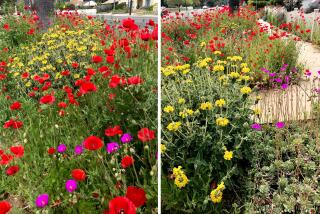Turns out tulips are wild at heart
- Share via
EVERYONE knows tulips. But do they? Consider species tulips, the wild ancestors of the traditional tulip. They are survivors, native plants found perched on the sides of scorching mountain passes and huddled in windy ravines in blazing arid Middle Eastern and Southwestern Asian countries such as Turkey, Iraq, Afghanistan, Kazakhstan and southern Mediterranean Europe. Hardened to summer drought, they are tough bulbs, a perfect fit for our Mediterranean climate, yet still overshadowed by their popular descendants.
Smaller and shorter-stemmed than their hybrid offspring, the charming and reblooming species tulips look like dainty wildflowers, intricately colored, mottled, solid or striped. On sunny days, their blossoms nod in the breeze and open wide as if to show off their dazzling colors. Peek inside the red and white candy stripes of Tulipa clusiana ‘Lady Jane’ and find a purple center. T. sylvestris is golden yellow, flushed in red. And it’s fragrant.
They’re ideal for rock gardens where plants are spare and low. Species tulips are not large or dramatic, and they can get lost jumbled up with bedding plants that detract from their beauty. They show off near a path, tucked into a corner or placed at the front of a dry border.
Although these tulips are not likely to rot from a few sprinkles, they need to spend summers in dry soil, like any other bulb when its root system is dormant, says Brian Sullivan, horticultural manager of Descanso Gardens in La Canada Flintridge. To keep bulbs moisture-free, plant between steppingstones where sprinklers don’t reach, or try them in dry spots where nothing has grown before.
Species tulips do need some water when their leaves break through the soil. Winter rain is usually adequate. However, if rainfall is much below average as it was last year, gardeners will need to water every two weeks until tulips bloom -- not much water, considering what other plants demand.
There’s still time to plant species tulips through December, says Jim Threadgill, owner of Easytogrowbulbs.com. Unlike classic tulips, these bulbs need no chilling. Simply plant in full sun or even under a deciduous tree. Sharp drainage is a must. Amend heavy clay soil with organic matter such as compost or pumice. Place the bulbs 3 to 4 inches into the soil, and water after planting. Once they bloom, these bulbs will return each spring without planting anew.
Brent Heath, co-owner of Brent and Becky’s Bulbs, likes his species tulips in pots. He recommends filling a pot three-quarters full of compost, placing the bulbs shoulder to shoulder, then covering them with crushed gravel.
“The gravel keeps the bulbs in the pot when they’re rooting and keeps critters, like squirrels, from digging up the bulbs,” he says. For tulips in the ground, Heath says, he feeds his soil, not his plants. “Plants are best on long-term sustainability. Add compost and humus to the soil. Even in Holland they’re getting away from using fertilizers. They add 2 to 3 inches of compost to the soil.”
When bulbs bloom, sometime between March and May, gardeners can either cut spent flowers or let them go to seed. Cutting the blossoms before seeds form means more energy goes back into the bulb for next year’s growth -- 30% more, Heath says. Leaves help convert the sun’s energy to food, so gardeners must put up with them as they yellow and wither.
A bonus for gardeners who have T. saxatilus: “Its leaves turn crimson as they fade,” says Catherine Ratner, who lives in Palos Verdes Estates and has gardened for 60 years. She planted T. saxatilus on her dry north-facing slope in 1985, and the luscious lavender/pink bulbs with butter-yellow centers have returned faithfully each year. She divides them after the leaves are gone, giving some to friends and moving others to new spots in the garden.
Some gardeners may find T. saxatilus too vigorous. It has thin underground stems that can extend a fair distance from the mother bulb and grow a new bulb at the tip of the stem, explains bulb expert Harold Koopowitz, professor emeritus in the department of ecology and evolutionary biology at UC Irvine and former director of the UCI Arboretum.
Most species tulips are well behaved and stay put, so why aren’t these striking bulbs seen more often in our gardens? Koopowitz offers an explanation.
“They’ve been underrated,” he says, “overpowered by the big garden monsters, gigantic colorful flowers.”
If that’s so, now is the time to begin thinking small.
--
--
(BEGIN TEXT OF INFOBOX)
Where to buy species tulips
Nurseries
Burkard Nurseries, 690 N. Orange Grove Blvd., Pasadena, (626) 796-4355. www.burkardnurseries.com
San Gabriel Nursery & Florist, 632 S. San Gabriel Blvd., San Gabriel, (626) 286-3787; www.sgnursery .com
Roger’s Gardens, 2301 San Joaquin Hills Road, Corona del Mar, (949) 640-5800; www.rogersgardens.com
Sperling Nursery, 24460 Calabasas Road, Calabasas, (818) 591-9111; www.sperlingnursery.com
Online
www.brentandbeckysbulbs.com
www.easytogrowbulbs.com
www.mzbulb.com






